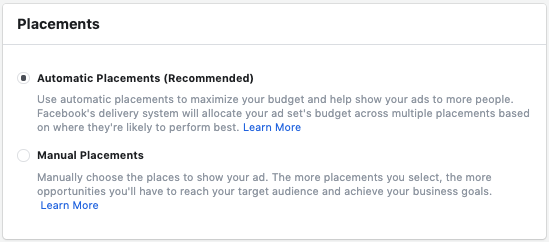If you’re at all familiar with the inner-workings of Facebook’s Ads Manager, you’ll know that Facebook ads can appear in many places, beyond the humble News Feed. Over the past five years, as part of its advertising arms race against Google, Facebook has dramatically expanded its advertising placements. With Instagram, Audience Network and Whatsapp (watch this space) under its wing, Facebook allows advertisers to reach audiences far beyond the confines of Facebook itself.
Although this opportunity to reach people in places all over the interweb sounds vast and grand, too many advertisers get caught out using ad placements that aren’t right for their brand, content, audience or objectives.
By default, Facebook Ads Manager sets placements to ‘all’. And meaner still, Facebook presents a slightly misleading warning that ‘removing placements may reduce the number of people you reach’. If you leave placement set to ‘Automatic’ as pictured below, your ads could appear to people in places that are good for no one.

That’s not to say you shouldn’t test various placements. Facebook is a clever cookie and the system will automatically show your ads where they’re likely to perform best. So our advice is to apply common sense when selecting your placements, preview placements before publishing, and use our guidelines below to decipher which placements will apply to you and your content.
Facebook News Feed
Your ads appear in the desktop News Feed when people access the Facebook website on their computers. Your ads appear in the mobile News Feed when people use the Facebook app on mobile devices or access the Facebook website through a mobile browser.
Good for:
Possibly the safest, most consistent placement of them all (as at March 2020, that is). Of the most commonly-known placements – Facebook News Feed, Instagram Feed, Instagram Stories or Facebook Stories (we’ll get to these, don’t worry) – Facebook News Feed placement tends to be cheapest and has the highest potential reach.
Not so good for:
The Facebook News Feed placement is tough to fault. However, if we were to speculate, we’d have to say that Instagram feed placement will one day conquer all, and the reach of the Facebook News Feed placement will dwindle, as users move elsewhere to consume their media.
Instagram Feed
Your ads appear in the mobile feed when people use the Instagram app on mobile devices. Instagram Feed ads only appear to people browsing the Instagram app.
Good for:
Engagement on Instagram in New Zealand is increasing with the growth of the platform. Instagram Feed placement tends to be effective for eCommerce objectives. Content centred around travel, food, leisure and fashion industries also tends to thrive on Instagram. Most ad formats present well in Instagram Feed, but best practice is to crop images and video to 1:1 ratio. To learn how to crop by recommended aspect ratios for different placements, click here.
Not so good for:
B2B brands, please steer clear. Instagram tends to be where audiences relax, so unless you’re bringing genuinely entertaining, not-so-business-y content to the Instagram table, stand down. Also, if you’re running a Facebook engagement campaign or a Facebook ‘page likes’ campaign, do not, I repeat, do not, include Instagram placements. Common sense, innit.
Facebook Marketplace
Your ads appear in the Marketplace home page or when someone browses Marketplace in the Facebook app.
Good for:
Facebook Marketplace is where users go to buy things. So if you’re selling a thing – in other words if your objective is eCommerce – this placement is just right for you.
Not so good for:
Although it’s not a horrible idea, selling an experience or service within Marketplace isn’t likely to bode well. Lead generation isn’t going to be easy in Marketplace, and don’t try sharing website or video content here either. We could go on, but essentially you want to get inside the brain of your audience and consider why they’re browsing Marketplace.
Facebook Video Feeds
Your video ads appear between organic videos in video-only environments on Facebook Watch and Facebook News Feed.
Good for:
You guessed it….Facebook video feed placement is good for video content! Thankfully, Facebook won’t let you use this placement unless your media type is video. Think about context when considering this placement – users consuming video feed content are often browsing mindlessly or have found themselves down a video rabbit hole. So make sure your content is quick, snappy and engaging because it’s likely your audience is on the brink of getting back to what they should be doing, and as soon as they’re bored or annoyed, they’ll do just that.
Not so good for:
Long, rambling talking head videos. In fact, they’re never good, so don’t do it. Facebook video feeds are also not so good for image ads, as mentioned.
Facebook Right Column
Your ads appear in the right columns on Facebook. Right column ads only appear to people browsing Facebook on their computers.
Good for:
Facebook’s right column placement is considered the old-school ad of the social realm – after all, it was Facebook’s first-ever advertising spot. Even though new placements have come along and won the hearts of most advertisers, we still see a lot of success come from the right column placement, particularly for less-text-heavy ads, and those with strong imagery.
Not so good for:
Right column ads truncate, and they don’t bode super well if you don’t have strong imagery. Don’t use video in the Right column, either. One last thing, bear in mind these will only present on audiences’ desktops, and they’re the first ads to be cut by ad blockers.
Facebook Audience Network
Includes: Native Banner and Interstitial*, Audience Network Rewarded Videos, Audience Network In-Stream Videos. Your ads appear in external apps and websites.
Good for:
The short answer is, proceed with caution. A lot of advertisers struggle to get their heads around this one. Facebook Audience Network is a group of websites and apps that Facebook has formed an agreement with, that will present ads on their platform, using targeting and budgets set within Facebook. Not many advertisers realise that TikTok is in fact one app on the publisher list. So if obscene lyrics, suggestive dancing, and fame-hungry adolescents suit your brand then go for it. Ultimately, if you’re confident enough to use blocklists, publisher lists, exclusions and reports to manipulate the Audience Network to work for you, then Godspeed.
Not so good for:
The catch is, advertisers can’t access a list of participating websites. We can upload block lists of websites we don’t want to appear on and choose to exclude gaming sites. We can upload ‘publisher lists’ of websites that we’d like to appear on for Facebook to use as inspiration, and once a campaign is live, we can see the top websites they did appear on. In other words, we can do everything but choose exactly where ads will end up. And so our advice is, unless you know exactly what you’re doing and how to manipulate the Audience Network, steer clear.
*An interstitial ad is a full-screen ad that you can show in your app. It’s OK, we just learned what this is ourselves!
Instagram Explore
Instagram Explore: Your ads appear in the browsing experience when someone clicks on a photo or video.
Good for:
As a relatively new placement, it’s a little early to gauge the effectiveness of Instagram Explore. However, as you can imagine, people who use Instagram Explore are likely to be open-minded, bored, looking for something new. And so, in theory, this placement is perfect for eCommerce, selling experiences or services, or even sharing quality content.
Not so good for:
Ads appear in a similar format to Instagram Feed, so consider our guidelines the same – B2B brands, please steer clear.
Messenger Inbox
Your ads appear in the Home tab of Messenger.
Good for:
Ads delivered directly to a user’s inbox can be considered invasive, but others might say they’re more… intimate. Messenger Inbox is a great idea for products or services that are considered more private or personal. Think dating services, hair re-growth products… anything that your audience might consider ‘embarrassing’ when consumed in public.
Not so good for:
Don’t bother using video or long, text-heavy ads – these will truncate to fit the placement.
Instagram Stories
Your ads appear in people’s Stories on Instagram.
Good for:
Stories are all the rage right now. The placement has one of the highest reaches, particularly amongst younger demographics – those under 40. Make sure to use snappy, eye-catching video or imagery. Oh, and this is the one placement the 20% text rule doesn’t apply, so get creative and go nuts! Content-wise, best practice is portrait-cropped video and imagery. For full specs, click here.
Not so good for:
Again, stay away, B2B brands. And if you don’t have super eye-catching, thumb-stopping imagery or video content, don’t bother clogging up users’ Stories. To learn how to crop by recommended aspect ratios for different placements, click here.
Facebook Stories/ Messenger Stories
For Facebook Stories, your ads appear in people’s Stories on Facebook. For Messenger Stories, your ads appear in people’s Stories on Messenger.
Good for:
In New Zealand, Facebook and Messenger Stories were slow to take off. However, now that users can post Facebook and Messenger Stories directly from Instagram, the placements are starting to pick up traction. If you’re using Instagram Stories, test Facebook and Messenger Stories too – what’s the worst that can happen?
Not so good for:
If you don’t have super-strong imagery or video content, don’t bother. And if you must use landscape-orientated content… it better be good.
Facebook Search Results
Your ads appear next to relevant Facebook and Marketplace search results.
Good for:
Far from the most popular placement, Facebook Search Results is well worth testing. But remember, when a user is searching for something, they tend to know what they’re looking for, and if your ads don’t hit that mark, they’re not going to engage. So if your objective is brand awareness, this one’s for you. If it’s website traffic, don’t bother.
Not so good for:
Ads truncate to fit in the search results, so make your message short and sharp. Not appropriate for video.
Facebook Instant Articles
Your ads appear in Instant Articles within the Facebook mobile app.
Good for:
This one’s the equivalent to Video In-Stream placement, but for people reading articles. That means it’s well suited to strong, well-crafted content and imagery.
Not so good for:
No video content please, and the placement is less appropriate for eCommerce than other placements. Also, beware that you don’t have control over which article your ad will appear next to. And so, in theory, a HELL Pizza add could well appear next to an article about the horrific flaming inferno of Australia’s bushfires.
Conclusion
There we have it – a rough guide to Facebook’s various ad placements. In summary, think before you ‘place’. First consider your content format, audience and objectives. Second, be strategic about it – use this article to inform what placements are right for you. Next, preview each placement before you publish your ads. And finally, test and learn and adjust. Simple, huh? If you’d like to chat more about the details of anything we’ve discussed here, get in touch.


By leaving a comment you agree with the storage and handling of your data by this website. You can learn more about how we handle you comment information in our Privacy Policy. We are using Akismet to reduce comment spam. Learn how they process your comment data.